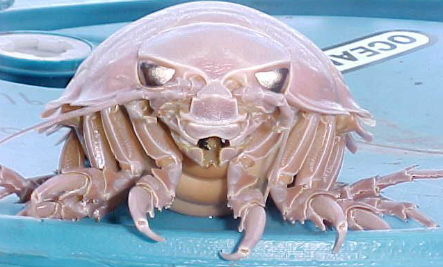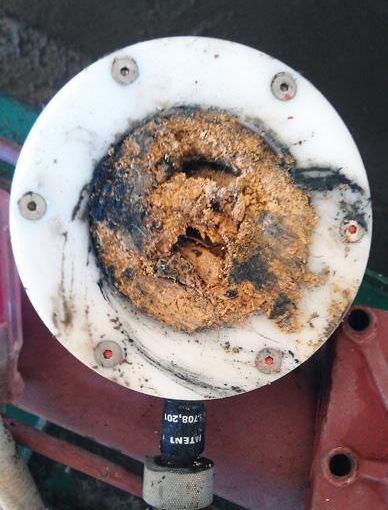Water News for January 2012
While you were busy breaking your New Year's Resolutions, a lot of important things happened in the world of water. Read on to hear all about it.
The International Bottled Water Association announced that it is important to drink water in winter as well as in summer. (A highly paid consultant figured that out.)
The Procter & Gamble Co. (P&G) announced it has provided its four billionth liter of clean drinking water through the P&G Children's Safe Drinking Water Program (CSDW). In case you're wondering, the 4 billionth liter went to a family in Thailand.
 |
|
Some creatures that live in the deep, deep ocean waters are from a world we can't imagine. This giant deep ocean isopod gets up to two and a half feet long. |
A series of earthquakes in Ohio have been blamed on the drilling of wastewater wells for fracking operations. "The earthquakes will trickle on as a kind of a cascading process once you've caused them to occur," said John Armbruster of Columbia University's Lamont-Doherty Earth Observatory in Palisades, N.Y. "This one year of pumping is a pulse that has been pushed into the ground, and it's going to be spreading out for at least a year."
Some Rio Rancho, NM residents said they are worried about their health after discovering greasy orange beads in their water supply. It was diagnosed as water softener resin, although the complaining homeowner did not have a water softener.
A tomato processing plant in Lemoore,CA responded to charges that its wastewater is producing foul odors and swarms of flies.
Benzene and other petrochemicals have been found in Kansas well water. A pipeline leak is the suspected source.
Water main replacement in Boulder Hill, IL has caused customers to complain of rusty water.
Pregnant women should not eat striped bass from New Jersey waters because of chemical contamination. That's the conclusion from recent tests of New Jersey's streams After billions of dollars spent, only one New Jersey brook passed the test.
 |
The FOG of Plumbing
The pipe above was clogged with FOG (wastewater treatment jargon for Fats, Oils, Greases).
According to a wastewater expert, "Most wastewater blockages can be traced to FOG. . . Blockages in the system are serious, causing sewage spills, manhole overflows, equipment failures and permit violations. Grease is one waste that the wastewater plant cannot handle and, therefore, needs to be kept out of the system, but most often is not. Grease traps are put into place to keep the grease out of the system and treatment plant, but the city allows the grease to be brought directly to the plant. This is unheard of in our industry unless the plant has a system installed to do so."
Read More.
|
Coal slurry contamination of water has been suggested as the cause of a "brain tumor cluster" in West Virginia.
The dreaded "norovirus" is being heavily promoted and will likely soon be a big vaccine seller. More on the Occasional's website.
Arsenic in Water
Adapted from Water Technology Online.
Arsenic is an odorless, tasteless semi-metal element that can enter drinking water naturally through erosion of the earth or agricultural runoff.
Arsenic occurs in two forms: Trivalent arsenic (AsIII, or arsenite) or Pentavalent arsenic (AsV, or arsenate).
Arsenic is usually harmful only after years of exposure. The EPA's maximum contaminant level is currently 10 parts per billion. This is a negotiable number that has in recent years been changed at least twice.
Water treatment for arsenic is by ion exchange, distillation, or reverse osmosis.
Testing for arsenic is crucial to making sure your water is clean and safe to drink.
Long term exposure to arsenic can cause stomach pain, nausea, vomiting, diarrhea, partial paralysis, numbness in hands and feet, blindness, and thickening and discoloration of the skin.
More information about arsenic.
All about Texas Water
Guide to Water In Texas
Texas is home to 14 major rivers, over 100 lakes, and 23 aquifers that underlie about three-fourths of the state. Texas also borders the Gulf of Mexico. These bodies of water supply much of the state’s drinking water. Some lakes and rivers are also used for energy production, though hydroelectric power is still a limited resource in the state.
More than half of the usable and potentially usable freshwater in Texas comes from groundwater. This water is used for domestic, municipal, industrial, and agricultural purposes. Nearly 55% of Texans rely on groundwater for their drinking water, and 96% of Texans are provided with water that meets or exceeds the primary drinking water standards.The Edwards Aquifer produces drinking water for more than 2 million people in Central Texas.
Demand for water in Texas has increased with the state’s rapid population growth. Austin, the state capital, saw its water use triple between 1970 and 2010. Texas’ mostly dry, hot weather and frequent droughts further stress the water supply.
The Texas Commission on Environmental Quality (TCEQ) and the Texas Water Development Board are in charge of regulating water quality. Contamination in groundwater from human waste is tracked by the Texas Groundwater Protection Committee. Gasoline, diesel, and petroleum products are the most common contaminants.
Lake Travis and Lake Buchanan are the main water sources for many cities, farmers and power plants in Central Texas. Droughts are a major concern in this part of the state where cities, like Austin, use lake water for drinking and recreation. Texas saw some of its driest months on record since 1895 during the eight-month period from October 2010 to May 2011. The water level in both Lake Travis and Lake Buchanan fell to 1.4 million acre-feet, 28 percent less than the average, causing the Central Texas region to begin stage 1 drought restrictions. As lake levels continued to fall, several Central Texas cities entered stage 2 drought restrictions, including Austin. As of June 20, 2011, nearly two-thirds of the state had entered into “exceptional drought,” the Lower Colorado River Authority’s (LCRA) most severe category. The LCRA is a powerful state organization that controls the water in the two lakes and much of the Colorado River.
Rice farmers along the Gulf Coast are also highly susceptible to the hazards of drought. Rice farming requires large quantities of water to produce crops. The 2011 drought has constrained water supplies to the point that rice farmers may face water restrictions in the coming year. In 2010, Texas’ agricultural industry used 57% of the water from the six Highland Lakes in Central Texas.
To ease water supply problems in Texas, the LCRA is looking for alternative water sources. State environmental regulators have approved the LCRA’s request to store more water downstream from Lake Travis and Lake Buchanan. State representatives are currently working on regulation of groundwater. New legislation for rain water harvesting in Texas passed in the 82nd legislative session and is effective September 1, 2011.
Water Softeners as a Human Rights Issue
Legislation to ban water softeners has long been a contentious issue. The desire of many cities to keep excessive salts out of their wastewater has prompted them to pass laws that ban or limit the use of conventional, salt consuming water softeners. Water treatment dealers, acting especially through trade organizations such as the Water Quality Association, have fought such bans through litigation, political action, research aimed at showing the environmental advantages of softened water, and public education. At the heart of the issue is the question of whether individuals have the right to improve water entering their home or if municipal governments have the right and the obligation to look after the public good at the expense of the individual's wishes.
Here's an informative article about a softener ban in a California city.
 |
A Few Things You Should Know about Chlorine
by Pure Water Annie
Chlorine has saved some lives and it has taken some.
|
Chlorine is a big part of our lives. It has hundreds of uses in addition to water treatment, but water is where most of us encounter it most frequently and most intimately.
Chlorine (or its near relative chloramine, which we'll discuss more fully later) is added to most public and many private water supplies to eliminate problems with bacteria, viruses, fungi, and algae. It is also used as an oxidant to aid in the treatment of such well problems as iron, manganese, and hydrogen sulfide.
Chlorine is a powerful germicide. It kills or reduces most disease-causing water contaminants to non-detectable levels. It also eliminates algae and mold that are problems for municipal water systems.
Chlorine, along with improved sanitation, is responsible for the virtual elimination in the US of such serious waterborne diseases as cholera, dysentery and typhoid. Waterborne ailments have not been erased by chlorination by any means, but the problem is minute compared to what it was before chlorination was used.
Lack of clean drinking water and adequate sewage systems is the main health problem in most of the under-developed world.
The effectiveness of chlorine as a disinfectant can depend on a variety of water variables. These include contact time (how long the chlorine remains in the water to do its work), the concentration of chlorine, and the pH, temperature, and turbidity level of the water.
Chlorine remains the disinfectant of choice for municipal suppliers largely because of its price. As compared with other forms of disinfection, such as ultraviolet, ozone, and hydrogen peroxide, it is cost effective. It is also the disinfectant of choice because of its residual effect: Chlorine (and chloramine to an even greater degree) stays in the water and continues to protect against micro-organisms, while UV and Ozone kill on contact but offer little if any "residual" protection. UV works great on wells, and it aids in the treatment program of many cities, but is not often used as the principal disinfectant.
Another problem with chlorine is that when it combines with organic substances in water it creates a group of spin-off chemicals called, variously, THMs (trihalomethanes) or DBPs (disinfection by-products). The full scope of the problems with DBPs is not known, but of the hundreds of chemicals that have been identified, some are known cancer causers and are regulated by the EPA.
Because of the DPB issue (and other issues, like the relatively shorter life-span of chlorine) water suppliers are in greater numbers switching to chloramines, a mixture of chlorine and ammonia, as the disinfectant for public water supplies.
The risks of cancer from contacting and ingesting chlorinated water have been downplayed by public health officials because the alternative of non-treatment is so much more dangerous. The World Health Organization has said that “the risk of death from pathogens is at least 100 to1,000 times greater than the risk of cancer from disinfection by-products (DBPs), and the risk of illness from pathogens is at least 10,000 to one million times greater than the risk of cancer from DBPs.”
The best and most practical method for removing chlorine (and chloramine) from tap water entering the home is carbon filtration. There are many subtleties involved in carbon filtration. Variables like pH, water temperature, flow rate, "mesh" size, arrangement of the carbon, and others can greatly affect carbon's effectiveness, but the truth is that almost any carbon filter, including the cheap, end-of-faucet units, will do a decent job of chlorine (but not chloramine) reduction from drinking water. (Shower filters, which must handle a much larger volume of water at a higher flow rate, most often are made with KDF rather than carbon.)
Reduction of chloramine is a much more complex process, but the urban legend that says that standard carbon water filters won't remove chloramine is false. Chloramines can be reduced by carbon, but more residence time is needed—a lot more. Some carbons are more effective with chloramines than others, and the very best, by far, is specially processed "catalytic" carbon.
A Sensible Home Treatment Strategy for Chlorine and Chloramines
The disinfectants in city water are there for a reason. They protect against pathogens. They should be in the water until it reaches your home, but at that point they become a problem rather than an asset. The problems are bad taste, chemical toxicity (which affects some more than others), and serious health issues involving both the disinfectant and its by products.
If your goal is simply to produce better tasting water by removing the taste of chlorine, a simple end-of-faucet filter will do.
If you want improved taste plus protection from chemicals (including DBPs), a serious carbon block filter is needed. The more carbon the better, and the higher the filter quality the better. DBPs are not effectively reduced by small end-of-faucet filters. Treating them requires more contact time and a larger and better carbon-based filtration system.. Multi-stage carbon filters are excellent. Virtually all undersink reverse osmosis units remove chlorine, chloramine, and DBPs easily.
For whole house treatment, a small carbon filter will remove chlorine, but a much larger filter, or a fairly large filter that uses catalytic carbon, is needed for chloramine.
 |
Numerical Wizard B. Bea Sharper ferrets out the watery facts that Harper's misses |
Rank of contaminated drinking water on the World Bank's 1992 list of preventable environmental hazards -- 1
Number of people in the underdeveloped world that lack clean drinking water -- 1 billion.
Number of people in the underdeveloped world that lack adequate sewage systems -- almost 2 billion.
Parts per million chlorine of common household bleach - 52,500.
Year in which US water utilities began treating water with chlorine -- 1908.
Percentage of US water utilities that now use chlorine or its derivatives to disinfect drinking water – 98%.
Year when chloramine was first used to treat water – 1916.
Percentage of US municipalities that now use chloramine as a disinfectant by EPA count – 30%.
Estimated number of trees that died in Texas because of the 2011 drought-- 500,000,000.
Happy Groundhog Day
|
